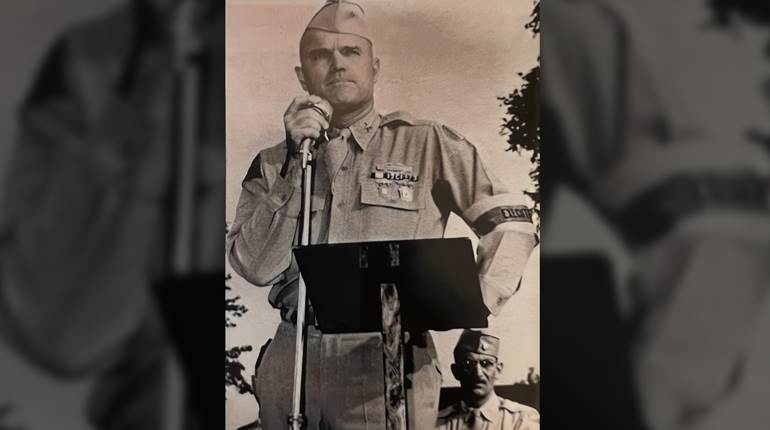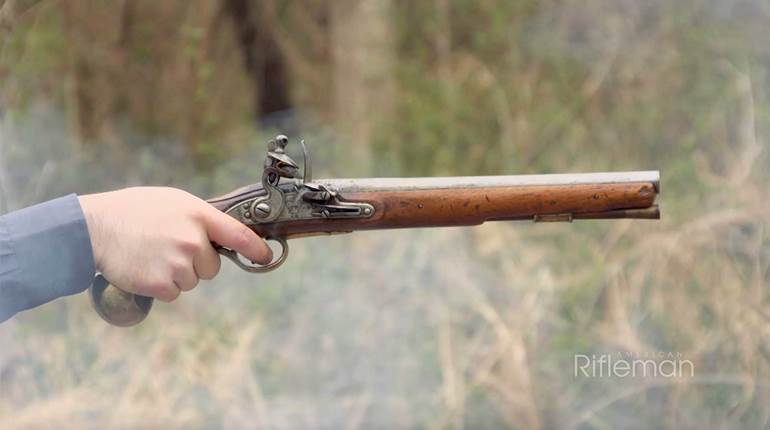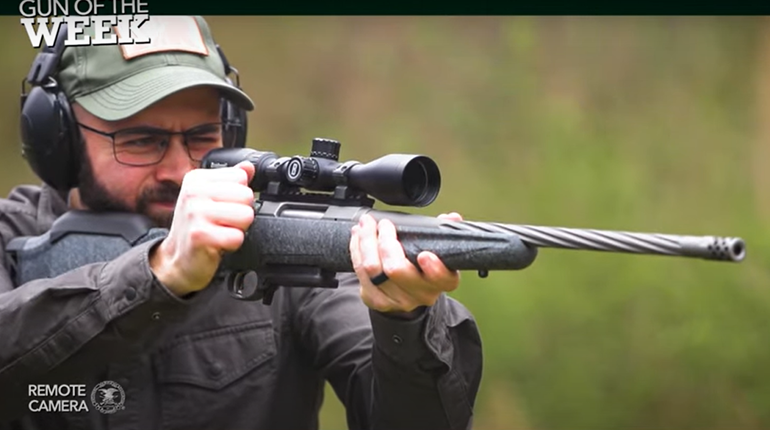
When we think of the D-Day invasion of Normandy in June 1944, images of Allied and German infantrymen locked in combat with the standard guns of 1944 come to mind.
We inevitably think of rifles such as the M1 Garand and the Lee-Enfield No. 4, Mk. I exchanging fire with German Kar98k Mausers. We picture the M1A1 Thompson submachine gun fighting it out with the German MP40, and the MG42 spitting bullets at British and Canadian light machine gun sections armed with the mighty Bren.
While these guns of D-Day certainly fought the battle, a variety of other firearms also provided the firepower that made Normandy so vicious and bloody. Among this variety were firearms that typically do not come to mind when one thinks of D-Day. Some oddities and oddballs showed up during the 10 weeks that followed June 6,1944, and they fought right alongside the firearms that are more familiar to us.

Hotchkiss Model 1914
Among the belt-fed machine guns that served both sides in France that summer, there were some surprises-especially on the German side. Although the Third Reich produced outstanding automatic arms before and during World War II, occasionally German troops were issued captured machine guns-such as the French Hotchkiss Model 1914 in 8x50 mm R Lebel.
At least one German unit was using that machine gun during the intense struggle for the city of Caen, because troops from the King’s Own Scottish Borderers (an element of the British 3rd Infantry Division) picked up a Hotchkiss Model 1914 and put it to their own use.
The interesting chain of custody that eventually resulted in British troops using a French-made machine gun that had been captured from the Germans reflects the unique and multi-national circumstances that made World War II an often complex global event.

Polish Ckm wz.30
The Wehrmacht also made good use of a captured water-cooled heavy machine gun in Normandy: the Ckm wz.30. Manufactured in Poland by Ciezki Karabin Maszynowy and chambered for the 7.92x57 mm Mauser cartridge, the wz.30 was capable of laying down sustained fire in a way that air-cooled machine guns simply could not. Franz Gockel was a corporal assigned to the 716.Infanterie-Division’s Grenadier-Regiment.726 at the Widerstandsnest 62 bunker complex on June 6.
From his fighting position looking down on the Fox Green Sector of Omaha Beach, Gockel directed fire on men of the U.S. 16th Infantry Regiment, 1st Infantry Division, when they began landing at 6:30 a.m. on June 6. He fired his wz.30 throughout the morning until being wounded and, thereafter, was evacuated for medical treatment.

U.S. M1917A1 Heavy Machine Gun
The bitter irony is that Franz Gockel killed an unknown number of Americans on D-Day using an obscure Polish machine gun that was based on John M. Browning’s M1917 design. That same design, chambered in the M2 .30-cal. Cartridge (better known as .30-’06 Sprg.), also saw extensive service in Normandy as the U.S. M1917A1 Heavy Machine Gun.
Although it had its origins in World War I, in 1944, the M1917A1 was employed by the 8th Infantry Regiment, 4th Infantry Division, and other ground-pounder units. But it was also a gun used by the Army Airborne forces. Since parachute infantry regiments could not easily jump with the cumbersome water-cooled Browning, they were armed instead with the lighter M1919A4 air-cooled machine gun.

In the 82nd Airborne Division’s 325th Glider Infantry Regiment though, heavy machine gun sections used the M1917A1. Following the successful liberation of the city of Ste.-Mère-Église during the pre-dawn hours of D-Day, the 82nd Airborne began attacking its other objectives. Among those objectives was the strategically important Merderet River bridge at the tiny settlement of La Fière.
There a 600-yd. causeway stretched across the marsh to the hamlet of Cauquigny. During the first three days of the invasion, the 82nd Airborne struggled with the German 91st Luftland Divisionto control the critically important hotspot in Normandy. Throughout it all, the glider infantrymen of the 325th used the M1917A1 Heavy Machine Gun to lay down sustained and effective defensive automatic fire.

Fallschirmjägergewehr Model 1942
Just as the 82nd and 101st Airborne Divisions had paratroopers in the fight in Normandy, so did the German 91st Luftland Division. Assigned to the 91st was the 6th Fallschirmjäger Regiment, a combat-experienced Luftwaffe unit that engaged the 101st Airborne Division in the area around the city of Carentan.
Known for being especially well-trained and well-equipped battlefield opponents, Germany’s Fallschirmjäger units were also remarkably well-armed. They carried the typical assortment of German infantry arms-the Kar98k Mauser carbine, the MP40 submachine gun and the MG42 belt-fed machine gun-but some of the regiment’s paratroopers carried the Fallschirmjägergewehr Model 1942-universally known as the FG42.
It combined the features of a hand-held infantry rifle and a squad automatic weapon. Firing the 7.92x57 mm Mauser rifle cartridge, the FG42 was most certainly not an underpowered carbine. With select-fire capability, it spanned the gap between rifle and machine gun. The FG42 was ahead of its time in that it fired from the open bolt in the full-automatic setting and from the closed bolt in semi-automatic.
That provided closed-bolt accuracy in semi-automatic mode and open-bolt heat dissipation in full auto-truly the best of both worlds. Even though Germany was well known for its high-quality automatic firearms during World War II, the FG42 was in a league of its own and it provided individual Fallschirmjäger with a superlative firepower capability.
The commanding officer of the 3rd Fallschirmjäger Division, Generalleutnant Richard Schimpf, was even known to carry one in combat as his personal arm when his division joined the battle in Normandy.

U.S. M3 "Grease Gun"
Like the German paratroopers, American paratroopers also carried automatic arms that provided a high volume of fire. Although they had nothing to compare to the firepower of the FG42, the men of the 82nd Airborne and the 101st Airborne were armed with submachine guns that could send a large number of bullets toward a target in very short order.
Anyone familiar with the American airborne in Normandy has no doubt seen photographs of paratroopers carrying the renowned Thompson submachine gun. Most frequently seen is the M1A1 Thompson, the model that was developed for mass-production and was manufactured by Auto Ordnance Co. of Bridgeport, Conn., and Savage Arms Corp. of Utica, N.Y. However, a limited number of the earlier M1928A1 Thompsons were carried by paratroopers during the campaign-some of which were still equipped with the iconic wooden vertical foregrip.
But by the summer of 1944, a new submachine gun was ready to join the ranks of the U.S. Army in Europe-a submachine gun that was being produced back in the States for less than half the cost of the cheapest mass-production version of the Thompson: the M3 “grease gun.”
In its World War II combat debut, the “grease gun” armed paratroopers and the crews of armored vehicles during the Normandy invasion. It was 2 lbs. lighter than the Thompson, it was handier than the Thompson-thanks to its collapsible stock-and it was a bargain for the U.S. government, with each unit costing a mere $20.94 delivered.
Although its cyclic rate was significantly slower than the Thompson’s, the M3 nevertheless fired the same 230-gr., .45 ACP. bullet and was, therefore, every bit as lethal.

Heeres-Küsten-Batterie Pointe Du Hoc 15.5-cm. K 418(f)
On D-Day, a force of 225 men from the U.S. Army’s 2nd Ranger Battalion was given the special D-Day mission of landing four miles west of Omaha Beach at a place called Pointe Du Hoc. After coming ashore, the Rangers would have to scale 100-ft. tall cliffs to conduct an assault against one of the most threatening German gun batteries in lower Normandy.
Established in May 1942, Heeres-Küsten-Batterie Pointe Du Hoc was a position armed with six French Canon de 155mm Grande Puissance Filloux (GPF) mle. 1917. The guns had been captured in 1940 and subsequently placed in German service with the designation 15.5 cm K 418(f). At Pointe Du Hoc, they were mounted on concrete traversing tables that extended their maximum effective range, improved their already impressive accuracy, and transformed them into formidable anti-ship weapons. The Ranger mission on D-Day, which was commanded by Lt. Col. James Earl Rudder, had the objective of preventing the guns from firing on the fleet.
At 7:10 a.m., Rudder’s force landed, scaled the cliffs, and swiftly pushed the enemy back from the battery area. That is when the Rangers discovered that no guns were mounted at the point. Instead, timbers had been placed on each of the six concrete traversing tables to present the false appearance that the battery remained armed.
The Rangers also found two casemates for heavy artillery at Pointe Du Hoc, but they were still under construction and their guns had not yet been mounted. In late April, the Germans removed the guns from the point to a position almost a mile to the south, but the Rangers did not know that at the time.
After they secured the battery position at the point, the Rangers moved on to the next phase of their mission, which was to set up a roadblock on the Vierville/Grandcamp road. While doing this, they put out flank security for the roadblock and quickly stumbled across the guns concealed along a hedgerow-enclosed lane.
First Sergeant Leonard “Bud” Lomell and S/Sgt. Jack Kuhn then used thermite grenades to destroy each gun’s traversing and elevation mechanisms. After that, Lomell used the buttstock of his M1A1 Thompson to smash the sights for each gun.
Although not designed for such a purpose, the Thompson nevertheless proved effective. Those 155 mm guns-among the deadliest guns of D-Day-never fired a shot in opposition to the Normandy invasion.

Vickers K Gun
Overnight on June 6 and 7, the Germans launched a series of powerful counterattacks that pushed the Rangers back to the point. By the time vehicles from Omaha Beach linked up with Rudder’s force at Pointe Du Hoc on June 7, the Rangers had suffered 135 casualties, mostly during the German counterattacks on the night of June 6.
In the aftermath of the intense battle, one particular memorial to a fallen Ranger was raised amid the craters and debris at Pointe Du Hoc. A U.S. M1 helmet was placed on top of the handgrip of a Vickers K Gun, the muzzle of which was stuck into the soil.
Although a British design chambered for the .303 British cartridge, K Guns were mounted on the ends of extending ladders that were, in turn, mounted on DUKW amphibious trucks. The plan was that the DUKWs would swim up to the beach, then roll up to the base of the cliff at Pointe Du Hoc and extend the ladders so that the K Guns could provide suppressing fire while the Rangers conducted their assault on the battery.

Because of its blended hand grip/trigger and 60-round pan magazine, the K Gun was anatomically well-suited for the mission in ways that the M1918A2 BAR and the M1919A4 .30-cal. machine gun were not. Of course, the Rangers could not expect to be resupplied with .303 cartridges, but they were not planning to use their K Guns beyond the morning of June 6, anyway.
When the ammunition ran out, it would be all over and the K Guns were to be discarded as the battle pushed inland. That is why a British automatic weapon can be found among the spent shell casings and exhausted smoke grenades at Pointe Du Hoc in the American sector of the invasion area.

Harrington & Richardson Model 50 Reising
The Vickers K Gun was not the only obscure firearm associated with the battle at Pointe Du Hoc. On the afternoon of June 6, the Rangers began sending prisoners down to the beach. They were not just German soldiers, but also Italian and French laborers from Organisation Todt who had been captured during the battle among Pointe Du Hoc’s craters.
When the prisoners reached the beach, they were loaded aboard landing craft being used to evacuate the wounded out to the ships lying just off shore. Although they ultimately ended-up aboard an LST (Landing Ship, Tank), at first the prisoners were taken to the battleship U.S.S. Texas (BB-35). With prisoners coming aboard, the ship’s Marine Detachment was called on to draw arms and serve as guards.
While the Marine NCOs carried M1911A1 pistols, the guards themselves were armed with one of the unlikeliest guns of D-Day: the Model 50 Reising submachine gun made by Harrington & Richardson. It may not be well-known, but U.S. Marines participated in the D-Day invasion, and many of them did so with their Reisings.

M1A1 Carbine
Even among the more common U.S. infantry firearms involved in the assault on fortress Europe there were some surprises. Because of its light weight and detachable, 15-round box magazine, the M1 Carbine saw widespread use during the invasion, but the straight stock version of the carbine was not the only configuration that fought the battle for Normandy.
The M1A1 Carbine, with its folding stock, was also present in large numbers. Although the fact that it showed up in the airborne division drop zones is not an altogether learned observation, the photographic record also reveals that the M1A1 made a few appearances on the invasion beaches, too.
As the battle developed on Omaha Beach on D-Day morning, a group of soldiers from L Company, 16th Infantry Regiment, 1st Infantry Division, together with some troops from the 29th Infantry Division’s 116th Infantry Regiment, sought shelter at the base of the high chalk cliffs of the Fox Red Sector.
In a photograph showing the mixed group gathered there, one man has the folding stock of his M1A1 Carbine tucked under his forearm while he cleans sand out of its action. An image captured at about that same time only 16 miles to the west shows troopers from the 101st Airborne Division’s 327th Glider Infantry Regiment gathering on Utah Beach. In that photograph, one man has laid his M1A1 Carbine on top of the seawall there before moving inland.

U.S. Model 1903 Springfield
The U.S. Army infantry rifleman who liberated France during the summer of 1944 did not always do so using the U.S. Rifle, Cal. .30, M1. Although the Garand was certainly the most abundant service rifle in use with American troops at the time, another rifle did the job alongside it: the Model 1903 Springfield.
From the sands of Omaha to the streets of Cherbourg, the ’03 was there through it all. In old and new configurations, it fought from June 6 through to the end of the campaign in the hands of soldiers from both support units and front-line combat units.
In fact, one of the most famous photographs taken in Normandy in June 1944 shows a group of soldiers carrying ’03 rifles while they climb the bluff above Omaha Beach. They are all from the 2nd Infantry Division’s 23rd Infantry Regiment, and they brought 1903 rifles to France that summer because their commanding officer told them to.
Col. Hurley E. Fuller, a World War I combat veteran, preferred the M1903 rifle, and he made sure that the men of his regiment carried it instead of the Garand. Thus, even as late as June 1944, the Model 1903 Springfield was the primary battle rifle of one of the infantry regiments attacking Hitler’s fortress Europe.

U.S. Model 1903A3 Springfield
The M1903 rifle also served in many of the other U.S. units fighting in Normandy during the summer of 1944. In fact, its use was so widespread that one particular photograph of an Ordnance Maintenance and Repair Company working in a hedgerow enclosed field near St.-Lô on July 18, 1944, shows hundreds of ’03s piled up and stacked high for servicing.
Although the photograph depicts only examples of the standard M1903 rifle, the newer M1903A3 was present for the Normandy battle as well. Modified for World War II mass production and manufactured by Remington and Smith Corona, the ’03A3 conserved precious raw materials and could be made faster and at less cost.
A product-improved version of the ’03, it was distributed among support troops from Military Police and Barrage Balloon battalions and shows up in photographs throughout the campaign, although with less frequency than the standard M1903 rifle.

U.S. Model 1903A4 Springfield Sniper Rifle
Still another version of the ’03 participated in the liberation of France: the M1903A4 sniper rifle. With its Weaver M73 (or M73B1) 2.75X scope mounted using the Redfield Junior base, the ’03A4 provided the U.S. Army’s only sniping platform during World War II.
Although it served many different units during the campaign, we know that at least one ’03A4 served in the 313th Infantry Regiment, 79th Infantry Division, because the rifle can be seen in a photograph taken in Cherbourg on June 26, 1944.
The photographic record provides some of the best documentary evidence of which firearms were being used where and when in Normandy.
For the most part, it shows the use of the standard small arms that we normally associate with Allied and German infantry battalions in combat during the summer of 1944. That same record leaves evidence of the interesting diversity of guns used on both sides of the fighting.
The surprises that showed up on the beaches and in the hedgerows of northern France that summer reveal the significant demands exerted on both sides of the conflict to put as many guns as possible in the fight.





































